

In SuperMap GIS 2024, SuperMap Software has further innovated the six major technical systems of GIS platform software (BRT-IDC), namely Big Data GIS, New Remote Sensing Software, New Three Dimension GIS, Geospatial AI, Distributed GIS, and Cross Platform GIS technology systems.
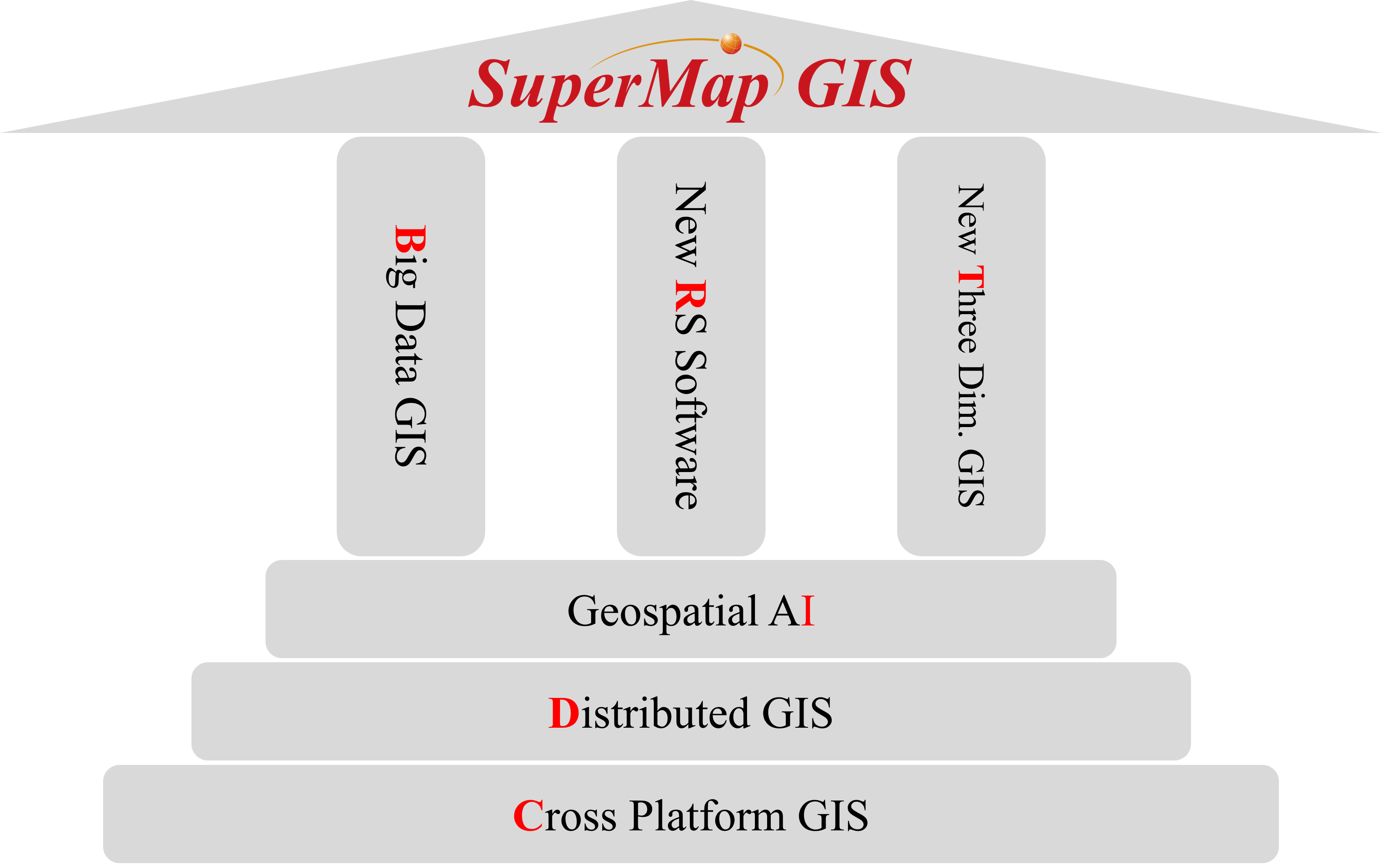
SuperMap GIS 2024 Technology Systems (BRT-IDC)
The big data GIS system includes the storage and management of geospatial big data, geospatial analysis, streaming data processing and visualization technology, dedicates to providing a comprehensive support for big data GIS infrastructure software and services, and making more users easily manage geospatial big data "gold mine".
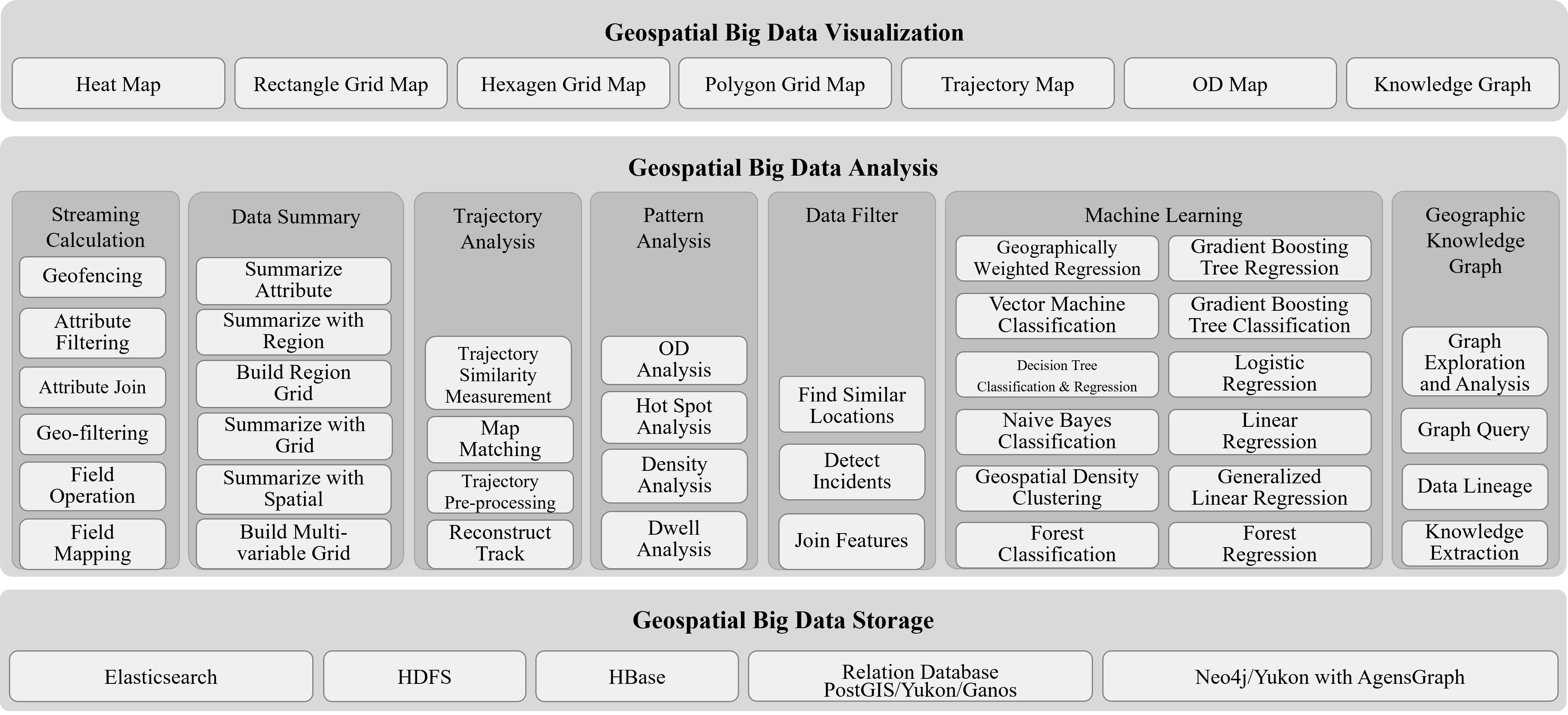
Big Data GIS Technology System
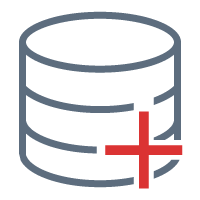
◇ Provides HBase and HDFS engines for large scale raster data.
◇ Provides Elasticsearch engines for streaming data.
◇ Supports customized extensible geospatial big data storage engine.

◇ Kernel level extended Spark geospatial data model.
◇ Supports 6 categories covering 200 kinds of geospatial big data analysis operator.

◇ Supports building entities and relationships based on structured data.
◇ Supports associating graph entities with spatial attributes to map window for browsing.
◇ Supports graph query and analysis.
◇ Supports handling data lineage relationships for automated processes, writing them into graph databases for traceability and tracking.

◇ Integrated open source map development library (OpenLayers, Leaflet, MapboxGL JS) and visualization library (ECharts, MapV, DECK.GL).
◇ Provides 2D / 3D and dynamic / static visualization effects.
◇ Provides spatial big data visualization technologies such as scatter map, heat map, honeycomb map, grid map, trajectory map, O-D map, flow map, etc.

◇ Provides built-in spark clusters and external spark cluster.
◇ Supports Hadoop cluster YARN mode.
◇ Supports 4 Spark deployment modes: local (single-process), local (multi-process), client, and cluster.
The next-generation remote sensing software technology system integrates internationally leading photogrammetry core algorithms, breaking through intelligent technologies such as the pre-trained large imagery model (LIM). It covers the full process capabilities of remote sensing image data storage management, production processing, interpretation and analysis, and visualization. This system achieves high-performance computing, remote sensing GIS integration, software cross-platform capability, intelligent processing and interpretation, cloud-native software architecture, and web-based interoperability, representing multiple technological innovations collectively referred to as "One High Five Transformations". These innovations significantly enhance the processing efficiency and interpretation accuracy of remote sensing imagery, enabling the rapid application of remote sensing data products on a T+1 basis.
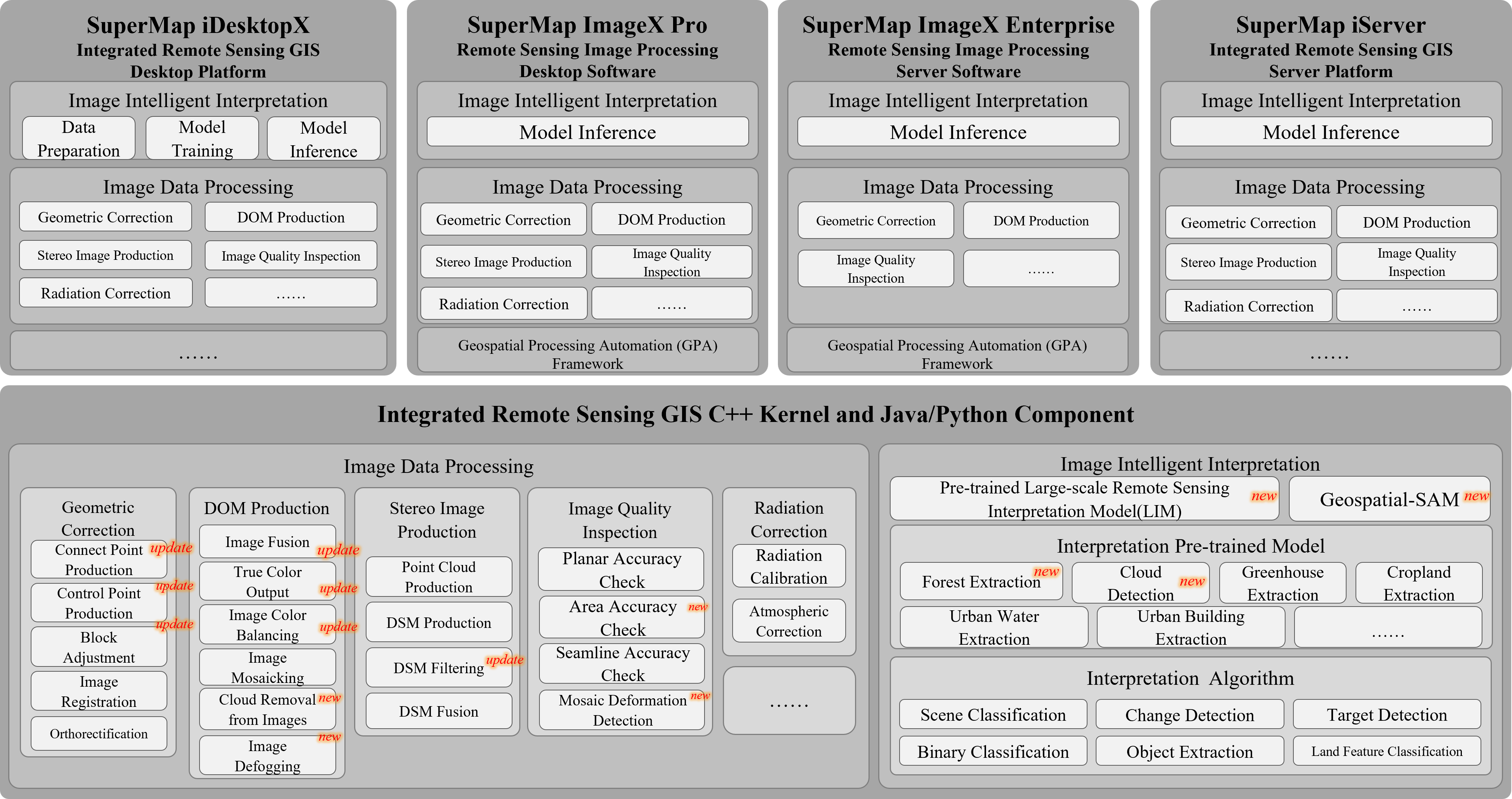
New Remote Sensing Technology System

◇ Supports processing of common satellite remote sensing data from GaoFen series, ZiYuan series, Beijing, GaoJing, Jilin, Sentinel, Landsat, IKONOS, WorldView, SPOT, and others.
◇ Supports managing intermediate and result data throughout the entire process in a mosaic dataset.
◇ Supports automatic generation of tie points and ground control points, enhancing geometric correction accuracy with AI semantics, and includes built-in AI heterogeneous image matching models to improve image matching accuracy.
◇ Supports block adjustment, offering linear, second-order polynomial, and third-order polynomial RPC correction models.
◇ Supports image registration, allowing for the registration of multispectral images based on geometrically corrected panchromatic images.

◇ Supports orthorectification, correcting the position and geometric distortions of original images based on adjusted RPC parameters.
◇ Supports image fusion algorithms such as Gram-Schmit and Pansharp, enabling users to control the sharpening effects of image fusion.
◇ Supports color output, synchronously adjusting image bit-depth and band sequence, enhancing output quality in vegetation areas.
◇ Supports image color balancing, using a reference image template to harmonize the colors of other images.
◇ Supports seamline generation, automatically avoiding linear features such as buildings, roads, or rivers.
◇ Supports output of result data in whole, standard subset, and polygonal clipping formats.
◇ Supports cloud removal, automatically replacing cloudy areas in image outputs.
◇ Supports haze removal, automatically enhancing contrast by removing thin haze and haze from images.

◇ Supports point cloud generation by performing dense matching on stereo images, producing dense point cloud data. Includes built-in AI dense matching models to effectively reduce mismatches.
◇ Supports Digital Surface Model (DSM) generation based on stereo images.
◇ Supports automatic filtering of DSM to generate Digital Elevation Model (DEM) products, utilizing AI filtering models that are particularly suitable for DSM filtering in urban areas.
◇ Supports DSM merging, combining multiple tiles of data into a single DSM covering the entire area.

◇ Supports planar and seam accuracy checks, displaying inspection points through thematic maps for visual assessment of result accuracy.
◇ Supports regional accuracy checks, facilitating detailed zone inspection of entire images.
◇ Supports deformation detection, automatically extracting areas with terrain, road, and building deformations.

◇ Supports generic radiation calibration models.
◇ Supports atmospheric correction for satellite sensor data from GF-1, GF-2, GF-6, GF-7, ZY3-02, etc.

◇ Supports image interpretation tasks including scene classification, change detection, object detection, binary classification, object extraction, and land cover classification across various scenarios.

◇ Provides ready-to-use pre-trained models for typical scenes like forest, farmland, urban water bodies, and urban buildings.
◇ Supports Large Imagery Model (LIM) for high-precision land cover classification in remote sensing interpretation.
◇ Supports G-SAM for fine-grained image segmentation by incorporating semantic information through spatial cues.
It is based on 2D & 3D integrated GIS technology, including 2D and 3D integrated data models and analysis calculations, multi-source 3D data storage management, multi-source 3D data sharing and interoperability, and multi terminals rendering interaction and output. It supports the storage, management, computation, analysis, visualization, and publishing of massive 3D data to achieve outdoor and indoor integration, macro and micro integration, and aerospace/surface/underground integration, and empower the application of full space new 3D GIS.
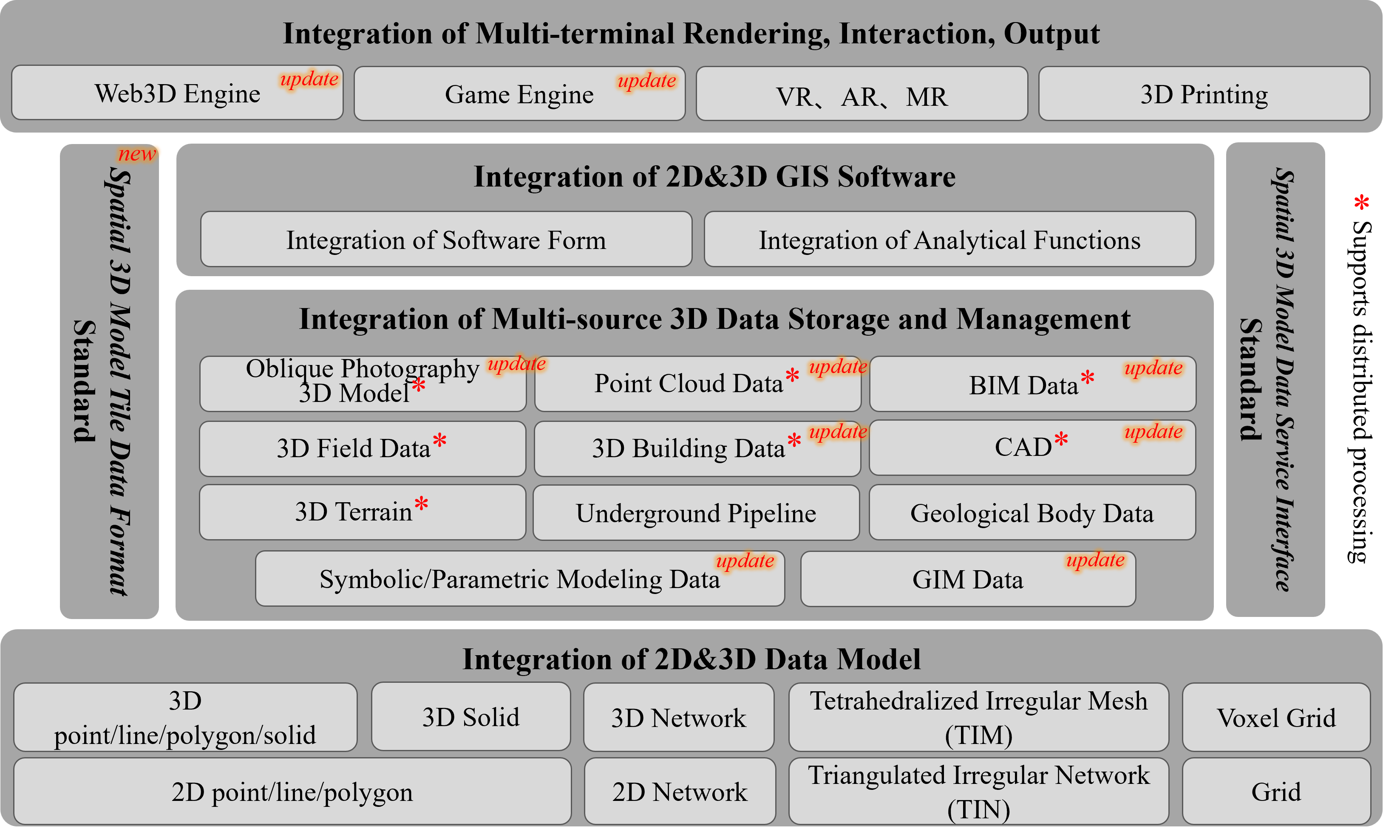
New 3D GIS Technology System

◇ Supports 2D data models such as 2D points/lines/surfaces, 2D networks, irregular triangulation networks, grids, etc.
◇ Supports 3D volume data model, and supports boundary notation and parametric notation.
◇ Supports 3D network data model, and supports indoor, outdoor, and overground and underground 3D network analysis.
◇ Builds two types of 3D field data models: Irregular Tetrahedral Grid (TIM) and Voxel Grid, and supports temporal dimensions.
◇ Provides rich analysis and calculation functions for 3D surface data, 3D volume data, 3D field data, etc.
◇ Supports symbolic modeling, rule-based modeling, and parametric modeling, and supports rapid construction of large-scale 3D scenes based on vector data.
◇ Provides operational functions such as stretching, dimensionality reduction, voxelization to achieve mutual conversion between 2D and 3D data models.
◇ New procedural building and road modeling tools (utilizing algorithms and program logic to create or modify models), capable of automatically batch constructing buildings, roads, and intersections based on vector data.

◇ Fully integrates multi-source heterogeneous data such as oblique photography 3D models, laser point clouds, BIM, GIM, white architecture model data, high-precision city model data, 3D fields, geological bodies, terrain, underground pipelines, etc.
◇ Supports direct access to data that meets standards such as IFC, CityGML, Geo3DML, GIM, etc., and supports cross-platform direct import of IFC (Industry Foundation Classes) data and storing them as different data types based on their classifications.
◇ Fully supports BIM data and access multiple formats of BIM data produced by over 10 mainstream BIM software. Added support for cross-platform direct import of RVT (Revit) data and DGN (MicroStation) data, including importing native BIM family component tree information.
◇ Provides multiple distributed GPA tools to realize efficient full process management and spatial analysis of 3D data such as white architecture model data, high-precision city model data, BIM, oblique photography 3D model, point cloud, terrain, etc.
◇ Comprehensively enhanced lightweight capabilities for massive data: reductions exceeding 30% in data volume for TB-level oblique photogrammetry 3D models, million-level BIM components, and complex urban models compared to original data.
◇ Fully optimized rendering performance for massive data: improvements exceeding 50% for TB-level oblique photogrammetry 3D models and million-level BIM components, and over doubling rendering efficiency for city models spanning hundreds of square kilometers.
◇ Supports incremental updates of white model tiles generated via face stretching, with automatic seam handling for local updates to oblique photogrammetry 3D models.

◇ Supports the surveying and mapping industry standard CH/T 9040-2023 "Spatial 3D Model Tile Data Format", along with providing corresponding open resources.
◇ Supports open standards for the Spatial 3D Model Data Format (S3M) and Spatial 3D Model Data Service Interface
◇ Supports the sharing and interoperation for white architecture model data, high-precision city model data, oblique photography 3D model, point cloud, BIM, GIM, 2D/3D point/line/polygon data, 2D/3D topological network data, geological body, 3D field in multiple terminals.
◇ Supports S3M 1.0, S3M 2.0 and S3M 3.0 format.
◇ Upgraded S3M 3.01 file storage format and vertex extended attributes to enhance efficiency in attribute queries, data scheduling, partial data updates, and on-demand multi-element requests.
◇ Supports for converting I3S data (conforming to OGC community standards) generated from oblique photogrammetry 3D models, BIM, urban fine models, point clouds, etc., into S3M data format.

◇ Provides self-developed 3D WebGL terminal and Cesium based 3D WebGL terminal, with full data, full functionality, high realism, and low code development.
◇ Independent developed 3D WebGL/WebGPU client enhances MVT data loading and display capabilities, as well as achieves highly realistic rendering effects for 3D scenes.
◇ Independent developed 3D WebGL/WebGPU client has been updated to support 3D Tiles 1.1 and I3S 1.3 formats, enabling the three-dimensional visualization of localized water bodies.
◇ Provides a high fidelity 3D GIS development package based on UE4/UE5/Unity/HMS Core 3D Engine, and supportsdynamic loading of large-scale, multi-source 3D GIS data, as well as multiple 3D GIS analysis, query, and measurement.
◇ Provides 3D GIS data beautification tools to achieve high fidelity rendering of 3D scenes (UE4/UE5/Unity).
◇ Supports cloud rendering to web terminal, provides open source JavaScript APIs, and supports low code development (UE4/UE5/Unity).
◇ Supports multiple VR/AR/MR devices:Oculus Quest2, iPhone, Microsoft HoloLens2, etc.
◇ Supports 3D printing.

◇ Provides 3D geographic design WebApp, supporting online batch modeling and interactive editing.
◇ Provides the iEarth WebApp for 3D Earth, supporting rapid setup of visual scenes, and enabling online browsing, querying, analysis, and sharing of scenes.
◇ Provides SuperMap iExplorer3D, and supports access to massive multi-source heterogeneous spatial data and high-fidelity 3D fields rendering.
◇ Supports 3D GIS cross platform.
Geospatial AI (Geographic Information AI) refers to the integration of artificial intelligence with geographic information software technologies. SuperMap AIF serves as the technological foundation for spatial intelligence, providing various AI capabilities including ready-to-use functionalities and customizable training and fine-tuning tools through AI process tools. SuperMap AIF empowers SuperMap's foundational software products and applications in industries such as natural resources information technology.
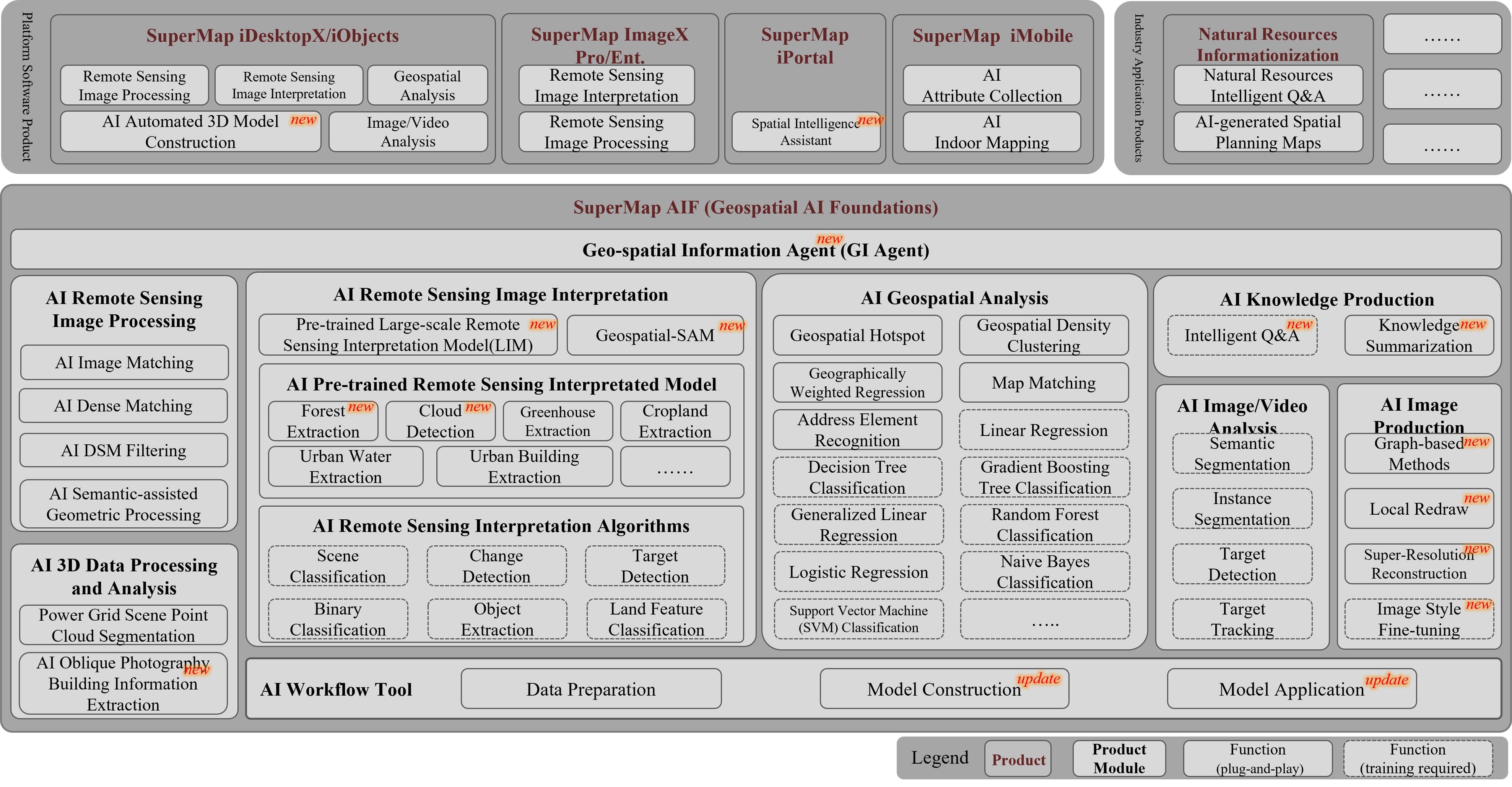
Geospatial AI Technology System

AI workflow tool
◇ Supports batch generation of training data during the data preparation stage.
◇ Supports training of multi-band remote sensing image interpretation models, along with capabilities for transfer learning and continuation training during the model construction stage.
◇ Supports various inference scenarios such as batch processing and range-based processing. Also includes capabilities for model eva1uation and conversion during the model application stage.
AI remote sensing image processing
◇ Built-in AI heterogeneous image matching models enhance the accuracy of matching different source images.
◇ Built-in AI pre-trained models for remote sensing interpretation utilize semantic information to remove non-ground points distributed in cloud-covered or built-up areas, enhancing geometric processing accuracy.
◇ Built-in AI dense matching models effectively reduce mismatches, improving the quality of Digital Surface Model (DSM) outputs.
◇ Built-in AI filtering models adapt to complex terrain conditions, particularly suitable for DSM filtering in urban areas.
AI Remote Sensing Image Interpretation
◇ Supports binary classification, land cover classification, general change detection, object detection, object extraction, scene classification, and other multi-scene image interpretation.
◇ Provides pre-trained models for various land covers such as forest land, farmland, urban water bodies, and urban buildings.
◇ New remote sensing interpretation pre-trained large model (LIM) capable of high-precision land cover classification.
◇ Supports G-SAM, enabling fine-grained image segmentation and the incorporation of semantic information through geographical prompts.
AI 3D Data Processing and Analysis
◇ Provides functionality for precise instance segmentation of point clouds, enabling accurate identification of objects such as power lines and towers.
◇ New capabilities for automatically extracting building outlines and identifying roof details, supporting the bulk construction of complex building entities.
AI Spatial Analysis
◇ Supports clustering analysis, including spatial hotspot analysis and spatial density clustering.
◇ Supports classification analysis capabilities, including map matching, address feature recognition, and forest-based classification.
◇ Supports regression analysis features such as geographically weighted regression, linear regression, and logistic regression.
AI Image/Video Analysis
◇ Supports image classification and object detection.
◇ Supports video Analysis, including capabilities for object detection, object tracking, object counting, speed analysis, geofencing, fight detection, license plate recognition, and supports custom sample training for video object detection models.
AI Image Generation
◇ New image generation feature that supports custom prompt words. It combines multiple reference images with various attribute constraints to generate intended images. These constraints include: sketch, outline, depth, line segment, semantic information, doodling, color, and lighting effects.
◇ New capability for local redrawing with support for custom prompts. This feature enables users to combine smudging, clicking, or text prompts to segment target areas for redrawing.
◇ New technical capability for super-resolution reconstruction, enabling customizable high-definition image enlargement using AI algorithms to enrich fine details in the image.
◇ New technical capability for fine-tuning image generation styles based on a small number of target style images. This feature allows for customizing generated image styles through refined model training.
AI Knowledge Generation
◇ New intelligent Q&A function for supporting batch upload of typical text materials such as doc, excel, pdf, etc., to build industry knowledge bases or provide fixed URLs. Based on a large NLP model, it enables the creation of custom scenario Q&A and supports answer tracing.
◇ Knowledge Summarization Functionality: Adds knowledge summarization function for uploading lengthy text materials. Based on a large NLP model, it provides functionalities such as summary generation, meeting minutes generation, topic analysis, long-text Q&A, and text profiling.
Geospatial AI Agent: SuperMap AgentX
◇ New technical capability for a geographic spatial intelligence agent. This feature enables users to submit spatial data processing requests through dialogue. It leverages advanced natural language processing models and AI agent technology to autonomously analyze, plan, and decompose tasks. Additionally, it interfaces with specialized spatial intelligence software tools to achieve specified objectives.

SuperMap iServer & iDesktopX
◇ Supports functionalities including AI remote sensing image processing, remote sensing image interpretation, spatial analysis, automated AI-driven 3D model construction, image analysis, and video analysis.
SuperMap ImageX Pro/Enterprise
◇ Supports capabilities such as AI remote sensing image processing and interpretation
SuperMap iPortal
◇ Supports interactive dialogue-based data resource retrieva1, analysis, visualization, portal management, and third-party functionality expansion through GI Agent.
SuperMap iMobile
◇ Supports AI capabilities for object recognition, detection, tracking, and counting.
◇ Supports AI mapping capabilities for indoor environments.

◇ Industry-specific applications in natural resource information can leverage various AI capabilities provided by SuperMap AIF. These include custom development of products such as intelligent Q&A systems for natural resources based on AI knowledge generation and spatial planning AI image generation applications.
It includes distributed geospatial data engine technology, geo-blockchain technology, distributed geospatial analysis and processing technology, cloud native GIS technology and edge GIS technology. It supports the storage, management, analysis, processing, visualization and publication of massive classic geospatial data and geospatial big data. Thus, it can realize the major breakthrough of GIS in high-availability, high-concurrency, high-performance, high-capacity and high-credibility to build a new distributed collaborative model of cloud, edge and terminal integrated GIS.

Distributed GIS Technology System

◇ Supports distributed geospatial file system, including HDFS, DSF, etc.
◇ Supports distributed SQL geospatial database.
◇ Supports distributed NoSQL geospatial database, including MongoDB, Elasticsearch, HBase, etc.
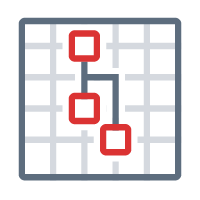
◇ Supports federated storage of blockchain geospatial data Fabric and IPFS.
◇ Supports blockchain certificate service management capabilities.

◇ Provides kernel level extended Spark geospatial data model.
◇ Supports more than 200 kinds of distributed processing automation modeling tools.
◇ Provides more than 70 kinds of distributed geospatial analysis operators.
◇ Provides the high-performance distributed dynamic rendering capability.

◇ Realizes the full microservice of map, 3D, big data,AI and stream data functions.
◇ Supports docker deployment and provides rolling upgrade, elastic scaling and error recovery of GIS node.
◇ Provides general automatic layout based on Kubernetes, which can realize the real time monitoring of all microservice resources.
◇ Integrated service grid technology supports gray publish, access control, service measurement, and service tracking.
◇ Integrates serverless technology, and supports running spatial analysis tasks, geographic processing automation tasks, distributed image cutting tasks and 2D/3D tile distribution tasksin a Serverless GIS function mode.
◇ Supports the use and conversion of cloud native GIS data formats and tile formats such as FlatGeobuf and PMTiles.

◇ Provides edge GIS products to build cloud, edge and terminal integrated application system.
◇ Supports pre-proxy, service aggregation, data distribution and analysis processing of edge GIS.
Since 2001, based on the standard C++, SuperMap has reconstructed the GIS kernel to build a set of native cross platform GIS technology system which has high performance and supports multiple CPUs, operation system has been established.
Now, SuperMap GIS supports multiple CPU architectures, like x86, ARM, MIPS, SW-64, etc. It can also run on Linux, Windows, Android and iOS with high-performance.
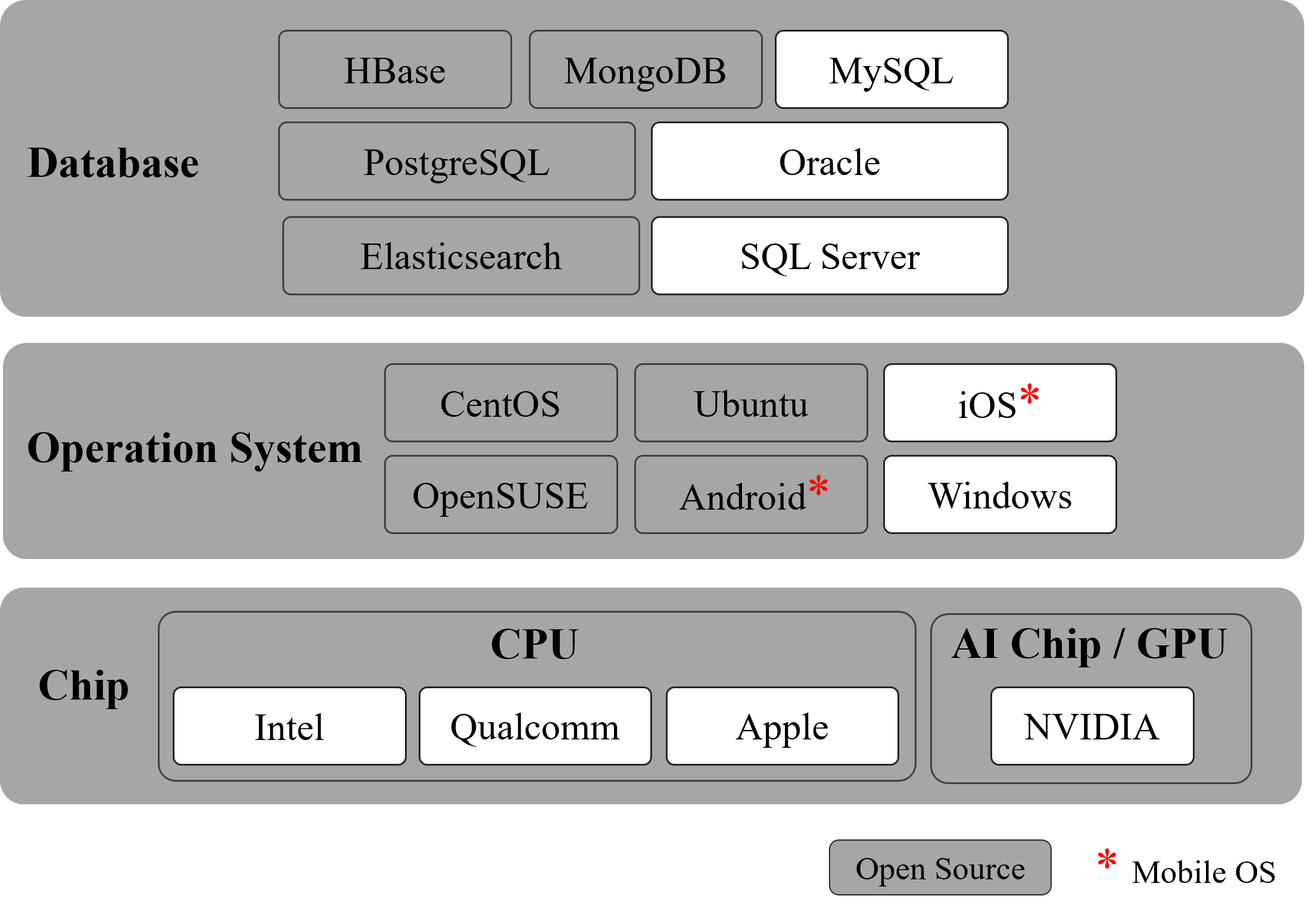
Cross-platform GIS adaptation (partial)

◇ CPUs: x86, ARM, MIPS, SW-64, etc.

◇ Operating systems: Linux, Windows, HarmonyOS, Android, iOS, etc.

◇ Supports database series: file type, relational type, NoSQL, etc.

◇ Cloud platform: public cloud, private cloud, etc.
